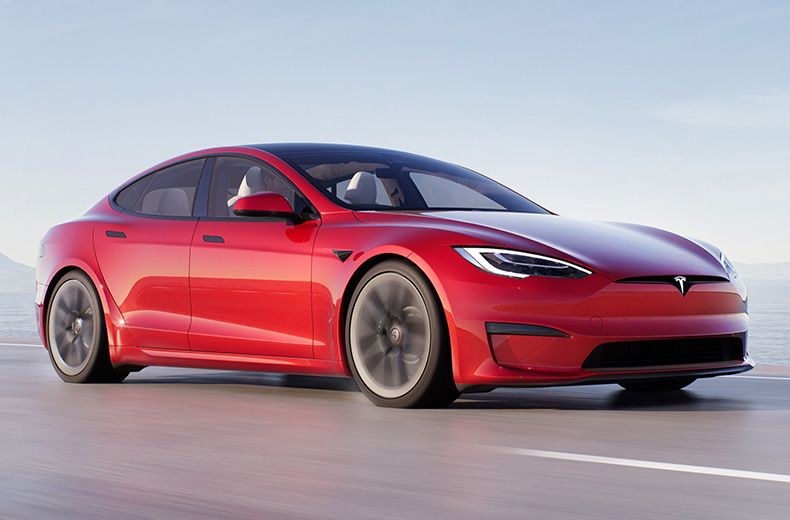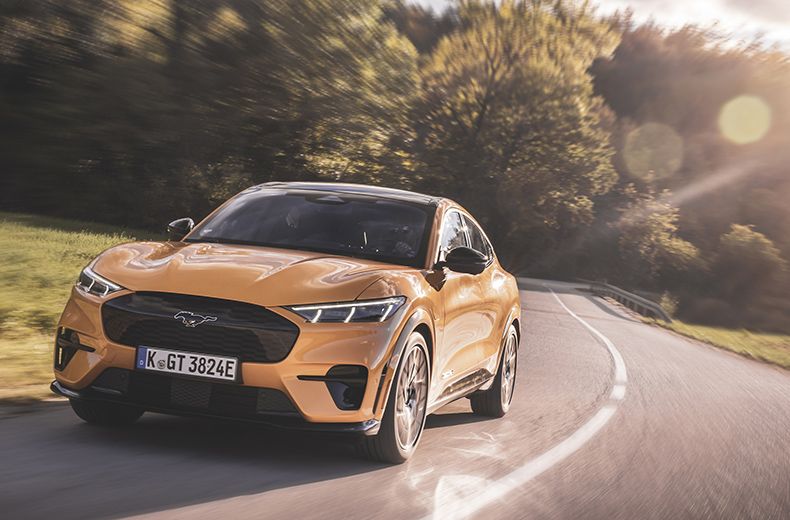EVs tend to have lots of acceleration from a standstill, and the experience is certainly one ‘wow factor’ of these vehicles.
As more powerful motors are developed, electric cars have taken on and surpassed conventional sports cars, both in terms of power output and maximum torque. The fastest road-legal EV of all, the Rimac Nevera hypercar, develops 1,914PS and blasts to 62mph in less than two seconds. If you have a runway long enough, it will reach 258mph.
Read on for our run-down of the fastest electric cars in 2022.
Fastest 5-seat electric cars

Audi RS e-tron GT
- Top speed: 155mph (limited)
- 0-62mph: 3.3 seconds
Audi’s electric models all wear the ‘e-tron’ badge, but the e-tron GT is the sportiest of the lot. Like the Porsche Taycan – with which it shares some components – it is a four-door saloon styled to look like a sleek coupe.
The RS is the flagship version of the e-tron GT line-up, with 646PS in ‘boost’ mode. That’s enough for 0-62mph in 3.3 seconds, helped by an incredible 830Nm of torque. Launch control provides full power for a maximum of 2.5 seconds.
The RS e-tron GT, similar to many electric cars of this type, has twin motors, with one on each axle to provide four-wheel drive. Its single-charge driving range is up to 283 miles and, with an 800V charging system, a five to 80 percent battery top-up takes less than 25 minutes via a 270kW rapid charger.
Read our Audi RS e-tron GT review

BMW i4 M50
- Top speed: 140mph
- 0-62mph: 3.9 seconds
BMW launched its electric ambitions with the radical i3 in 2013. Now that car is being discontinued, the baton is handed to the i4. An electric four-door ‘sports coupe’ based on the 4 Series Gran Coupe, the i4 is an important car for BMW. In M50 guise, it’s also the first all-electric performance car from the marque’s M division.
Its performance figures certainly live up to the badge. The range-topping i4 M50 has 544PS and peak torque of 790Nm. That translates into a 0-62mph time of 3.9 seconds, yet the i4 M50 has a single-charge driving range of up to 316 miles.
The M50’s electric motors sit on the front and rear axles, and beneath the aggressively styled body is M-specific chassis technology with all-wheel drive, individually configurable suspension, variable sport steering, M Sport brakes and 20-inch alloy wheels.
Read our BMW i4 review

Mercedes-AMG EQS 53 4MATIC+
- Top speed: 155mph (limited)
- 0-62mph: 3.8 seconds
Premium car maker Mercedes-Benz has seemingly launched a whole range of electrically powered models at breakneck speed. The EQ family now spans six cars, in saloon, SUV and MPV (people carrier) body styles.
The EQS is a big luxury electric saloon, but that doesn’t prevent it from offering prodigious performance. Sitting at the top of the EQS family tree, the EQS 53 4MATIC+ has a mighty 658PS and 950Nm of torque. That translates into a 0-62mph time of 3.8 seconds. Not bad for something that weighs 2.6 tonnes.
Being a Mercedes-Benz – even one tweaked by in-house tuner AMG – the EQS 53 4MATIC+ can seat five passengers in luxury for up to 358 miles on a single charge. When that is depleted, a 10-80 percent charge takes 31 minutes on a 200kW charger.
Read our Mercedes-Benz EQS review
- Electric cars – a definitive guide and tips for buyers
- Find out more about the RAC’s electric car leasing deals
- What are the benefits of electric cars?

Porsche Taycan Turbo S
- Top speed: 162mph
- 0-62mph: 2.8 seconds
As the number of electric vehicles grows, it was inevitable that manufacturers such as Porsche would launch an EV. However, in keeping with the German company’s heritage, it was never going to be anything other than a true sports car.
Although the Taycan is available in rear-wheel-drive, entry-level format with 408PS – more than enough power for most – the range-topping Taycan Turbo S has an incredible 761PS, and can reach 62mph in just 2.8 seconds, thanks to 1,050Nm of torque.
All this from a four-door saloon, remember, which can seat four or five people in luxury and comfort, and has a single charge range of at least 273 miles. Just don’t expect a turbocharger in the Taycan Turbo – it doesn’t use one.
Read our Porsche Taycan review

Tesla Model S Plaid
- Top speed: 200mph
- 0-60mph: 1.99 seconds
Think ‘fast EV’ and the Tesla Model S will perhaps be the car that first springs to mind. It impressed the moment it was first launched back in 2012, and has long set a performance standard for electric cars.
It used to be the ‘Ludicrous Mode’ of certain Tesla Model S models that set the pace. For 2022, though, it’s the Model S Plaid that drops the gauntlet for other EVs to pick up. With an incredible 1,020PS, the Model S Plaid has more power than most supercars.
Indeed, with a 0-60mph time of 1.99 seconds (with rollout subtracted) as well as a claimed top speed of 200mph – when equipped with cost-extra hardware upgrades – it is a true super-saloon that still boasts five seats and a very practical 396-mile range.
Read our Tesla Model S Plaid review
- 2030 ban – is it worth buying an electric car now?
- Electric vehicle range – how far can I drive in an EV?
- The road to electric – in charts and data
Fastest electric SUVs

Ford Mustang Mach-E GT
- Top speed: 124mph
- 0-62mph: 3.7 seconds
The Mustang Mach-E heralds the arrival of Ford’s electric era. Taking an iconic name and placing it on a family-friendly SUV might seem like sacrilege to some, but the electric high-rider certainly has the performance that Ford’s pony cars are known for.
The Ford Mustang Mach-E GT packs 487PS from its two motors, along with 860Nm of torque, funnelled to the road by all-wheel drive. The 88kWh battery gives a range of up to 310 miles.
The high-performance Mustang Mach-E GT gets to 62mph from rest in 3.7 seconds, which makes it Ford’s fastest accelerating five-seater in Europe ever. A new Untamed Plus driving mode is designed to help drivers balance the power on-track for consistent lap times, proving this Ford electric SUV isn’t just for the school run.
Read our Ford Mustang Mach-E GT review

Lotus Eletre
- Top speed: 162mph
- 0-62mph: 2.9 seconds
Unveiled in early 2022, the Lotus Eletre will reach showrooms in 2023. However, we’re including it here as the performance of the strikingly styled SUV should live up to the British car maker’s ‘Hyper-SUV’ billing.
With a minimum of 600PS, and incorporating weight-saving carbon fibre and aluminium materials, the Eletre has a targeted 0-62mph time of 2.9 seconds, along with a 373-mile range.
Designed to speed through the air more efficiently thanks to its clever active aerodynamics package, the Eletre is a sign of things to come from Lotus. The company’s first all-electric model apart from its Evija hypercar, the Eletre spearheads a new family of Lotus EVs that will include a four-door sports coupe and a smaller SUV.
Read our Lotus reviews

Tesla Model X Plaid
- Top speed: 163mph
- 0-60mph: 2.5 seconds
The Model S Plaid doesn’t have it all its own way when it comes to ultra-fast Teslas. Granted, the Model X Plaid SUV isn’t quite as quick, but 2.5 seconds to 60mph (rollout subtracted) is hardly a time to be sniffed at.
It uses the same twin-motor and all-wheel-drive set-up as its Model S sibling. That means a power output of 1,020PS – in an SUV! – and 333 miles of all-electric distance from its batteries. And of course, being a Tesla, the Model X Plaid can be rapid-charged using the extensive Supercharger network.
The big difference with the super-SUV over the Model S is its increased passenger space, with seating for up to seven people. There are also its signature Falcon Wing doors, which open automatically and are almost guaranteed to inspire a sharp intake of breath.
Read our Tesla Model X review
- Electric car charging – how it works and how much it costs
- Make EV charging easier with the RAC home charge point installation service
- Electric and hybrid cars reviews
Fastest electric sports cars

Lotus Evija
- Top speed: 200mph+
- 0-62mph: 3.0 seconds
Unveiled in 2019, the Lotus Evija marked a new era for the Norfolk sports car maker. An unashamed ‘hypercar’, it doesn’t pack a V10 or V12 engine under its sleek and aerodynamic body, but an electric powertrain. Four electric motors give the zero-emission Lotus a massive 2,000PS.
While there is no on-sale date yet, Lotus is targeting a sub-3.0-second 0-62mph time, plus a top speed of over 200mph. An ultra-lightweight carbon fibre body keeps weight down to just 1,680kg, and a mid-mounted bank of batteries conforms with Lotus’ acclaimed mid-engined sports car layout.
Even though it is equipped with four-wheel drive, that impressively low weight should help the Evija achieve its targeted electric driving range of 215 miles from a 70kWh battery. Here are some more numbers: the Evija has 1,700Nm of torque, and £250,000 secures one of the car’s 130 production slots.
Read our Lotus reviews

Rimac Nevera
- Top speed: 258mph
- 0-62mph: 1.97 seconds
Another outrageously powerful electric hypercar comes in the shape of the Rimac Nevera. Designed, developed and built by Rimac Automobili in Croatia, the Nevera project began as far back as 2011. The first customer Neveras will be delivered in mid-2022.
Similar to the Lotus Evija, the Nevera has four electric motors – bespoke to Rimac – for a total of 1,914PS, which blasts the sleek sports car to 0-60mph in just 1.85 seconds. The 2,360Nm of torque means it only takes another 2.5 seconds to reach 100mph, too. Astonishingly quick, the Nevera has been independently verified as the fastest accelerating production car in the world.
Fitted with a 120kWh battery as standard, Nevera production is limited to 150 units. You need deep pockets to afford one, though, the £1.7 million price tag elevating it to a place just as out of reach as many of its performance figures.
The RAC is leading the way when it comes to supporting drivers in the switch to electric vehicles.
A growing number of our patrol vans have built-in emergency mobile charging systems that can give an out-of-charge electric car enough power to be driven a short distance home or to a working charge point.
Find out more about RAC EV Boost.
Our All-Wheels-Up recovery system also allows our patrols to rescue electric cars safely with no need for a flatbed. Find out more about RAC Electric Car Breakdown Cover.
RAC Breakdown Cover
Join the RAC and get breakdown cover. Our patrols fix 4 out of 5 vehicles on the spot, with repairs done in just 30 minutes on average.












